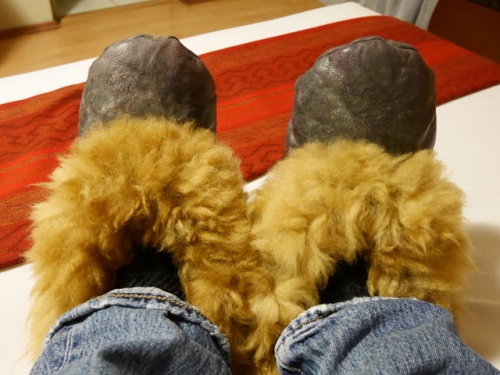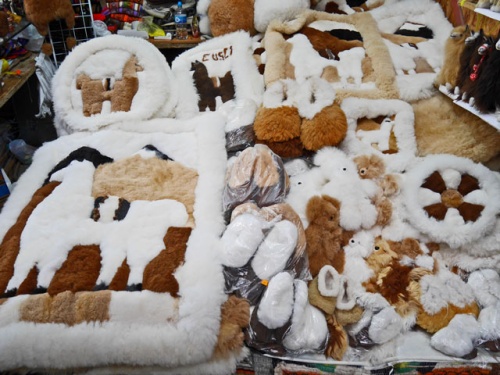Difference between revisions of "Alpaca fur & Llama fur"
(Created page with "<p align=center> 300px </p> Lamas und Alpakas kommen in den Anden [https://www.youtube.com/watch?v=xSQ_fwiPD0M&list=PLdGEmp0I4Baz_GnIfpGP8t0s...") |
|||
| (9 intermediate revisions by one user not shown) | |||
| Line 4: | Line 4: | ||
| − | |||
| − | + | Llamas and alpacas are commonly found in the Andes of South America. Although predominantly used as pack animals, they are also a source of food, wool and leather. Alpacas are smaller and sturdier, while llamas have more pointed ears. Both animals have [[Fur - Fur skin|fur]] designed to protect them against extreme cold, which can be as low as minus 40 degrees at night in the high Andes. | |
| + | |||
| + | The wool and fur of the alpaca have special characteristics. Their hair is fat free, hollow and very fine. Hair without fats is anti-allergenic. The hollow hair structure is excellent for cold weather. Alpaca hair has a thickness of 0.02 millimetres and is strong and soft. Therefore, it does not scratch. In comparison, a human hair is 0.06 millimetres thick. Alpaca herds are also kept in other countries and regions mainly to extract wool. | ||
| Line 14: | Line 15: | ||
</p> | </p> | ||
<p align=center> | <p align=center> | ||
| − | '' | + | ''Alpaca at Lake Titicaca and Lama at Salar de Uyuni in Bolivia.''<br></p> |
<p> </p> | <p> </p> | ||
| Line 22: | Line 23: | ||
</p> | </p> | ||
<p align=center> | <p align=center> | ||
| − | '' | + | ''Roasted alpaca in Peru, Machu Picchu, Llama steak in Bolivia, La Paz.''<br></p> |
<p> </p> | <p> </p> | ||
<p align=center> | <p align=center> | ||
| − | [[bild:Alpakafell-01.jpg| | + | [[bild:Alpakafell-01.jpg|500px]] |
| − | + | ||
</p> | </p> | ||
<p align=center> | <p align=center> | ||
| − | + | [[bild:Alpakafell-02.jpg|500px]] | |
| + | </p> | ||
| + | <p align=center> | ||
| + | ''Wonderful warm Alpaca fur slippers from Lima in Peru. - Alpaca fur-[[Leather accessories|accessories]] from the market in Aguas Calientes, Peru, below Machu Picchu.''<br></p> | ||
<p> </p> | <p> </p> | ||
| − | |||
| − | |||
| − | |||
== Additional information == | == Additional information == | ||
| − | * [[ | + | * [[Hide - Skin]] |
| − | * [[ | + | * [[Fur - Fur skin]] |
| + | <br> | ||
| + | * [[Sheepskin - Lambskin]] | ||
| + | * [[Cow hide]] | ||
| + | * [[Sealskin leather]] | ||
| + | * [[Beaver fur]] | ||
<br> | <br> | ||
| − | * [[ | + | * [[Exotic leather]] |
| − | + | ||
| − | + | ||
| − | + | ||
Latest revision as of 14:07, 27 August 2022
Llamas and alpacas are commonly found in the Andes of South America. Although predominantly used as pack animals, they are also a source of food, wool and leather. Alpacas are smaller and sturdier, while llamas have more pointed ears. Both animals have fur designed to protect them against extreme cold, which can be as low as minus 40 degrees at night in the high Andes.
The wool and fur of the alpaca have special characteristics. Their hair is fat free, hollow and very fine. Hair without fats is anti-allergenic. The hollow hair structure is excellent for cold weather. Alpaca hair has a thickness of 0.02 millimetres and is strong and soft. Therefore, it does not scratch. In comparison, a human hair is 0.06 millimetres thick. Alpaca herds are also kept in other countries and regions mainly to extract wool.
Alpaca at Lake Titicaca and Lama at Salar de Uyuni in Bolivia.
Roasted alpaca in Peru, Machu Picchu, Llama steak in Bolivia, La Paz.
Wonderful warm Alpaca fur slippers from Lima in Peru. - Alpaca fur-accessories from the market in Aguas Calientes, Peru, below Machu Picchu.
Additional information














 a kotori web solution
a kotori web solution